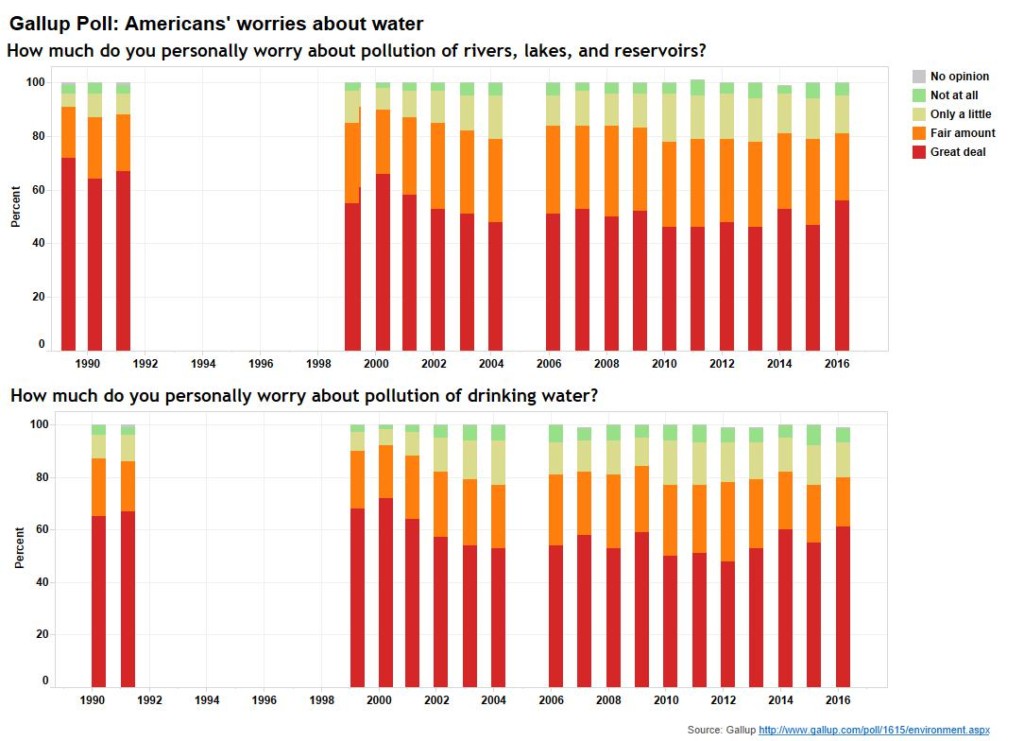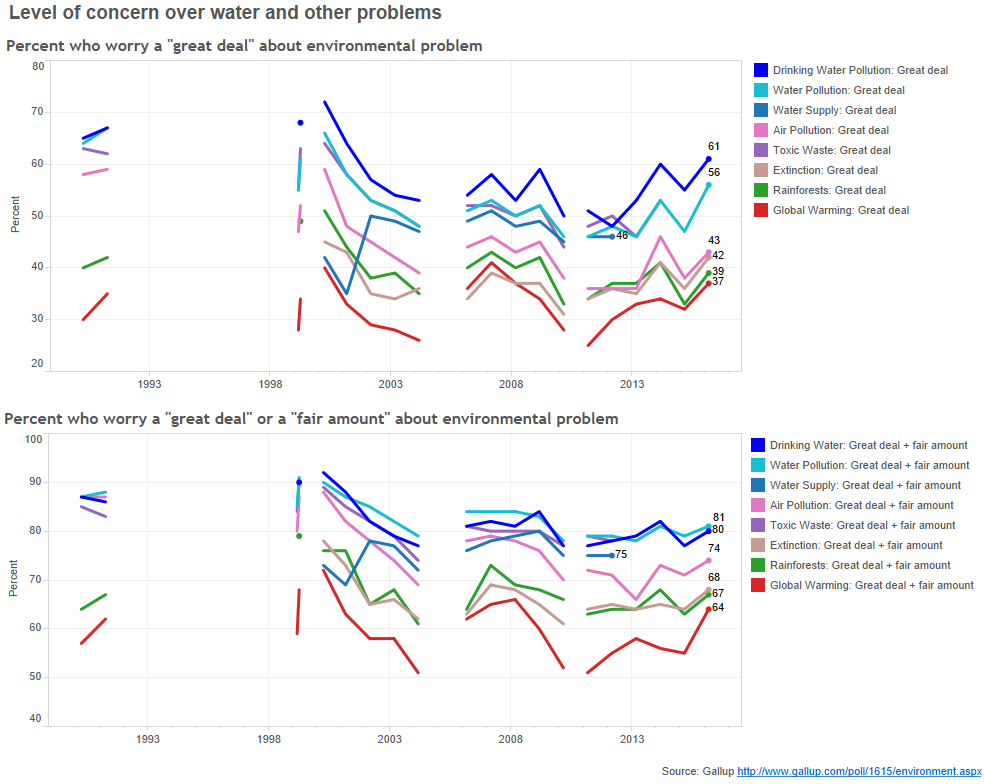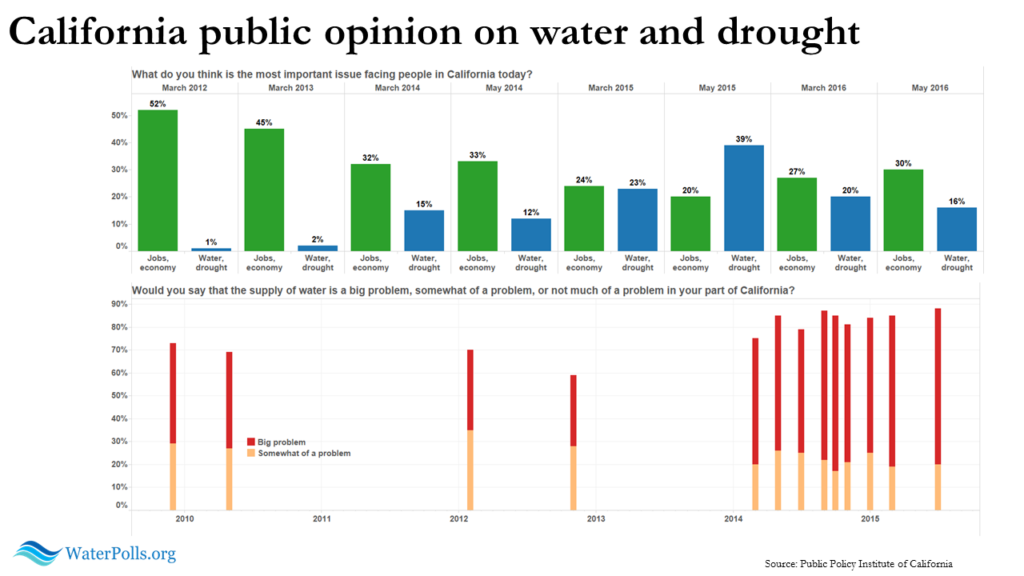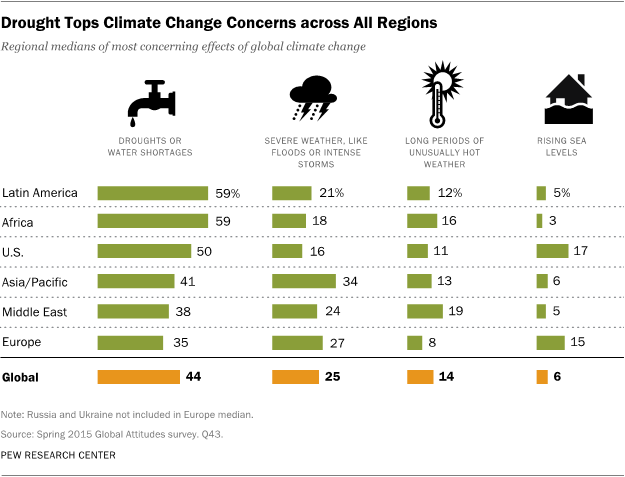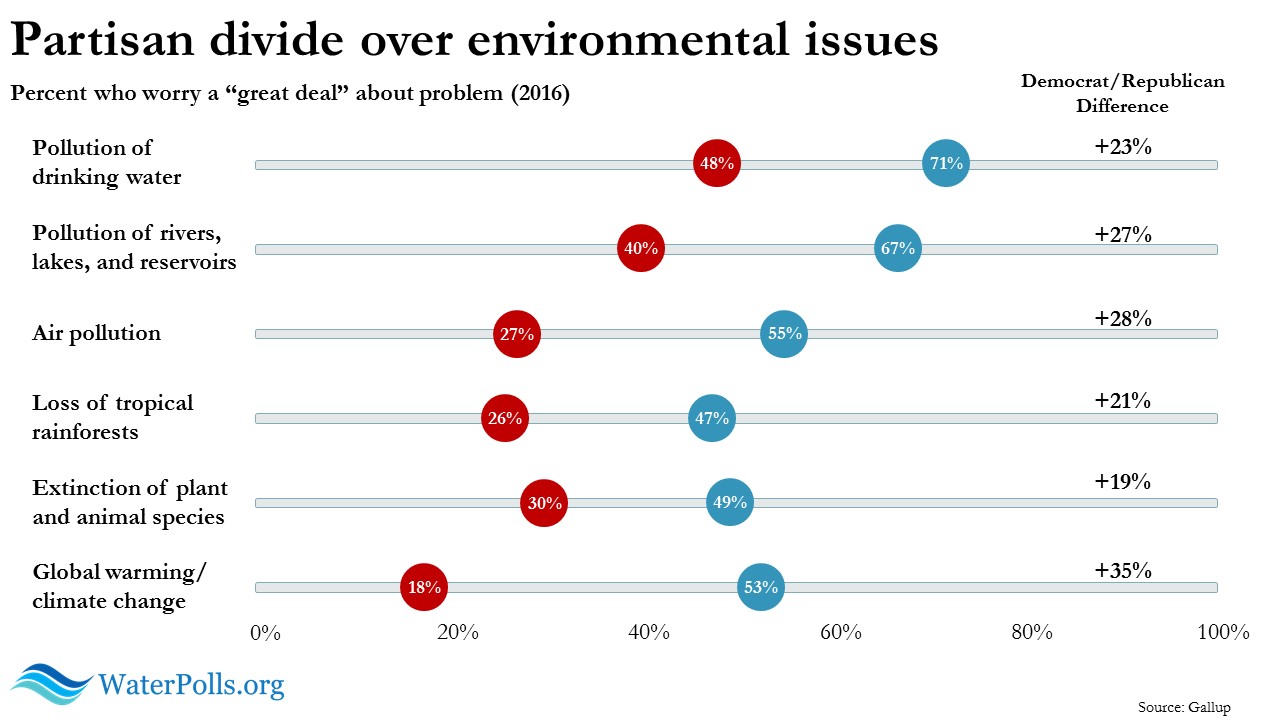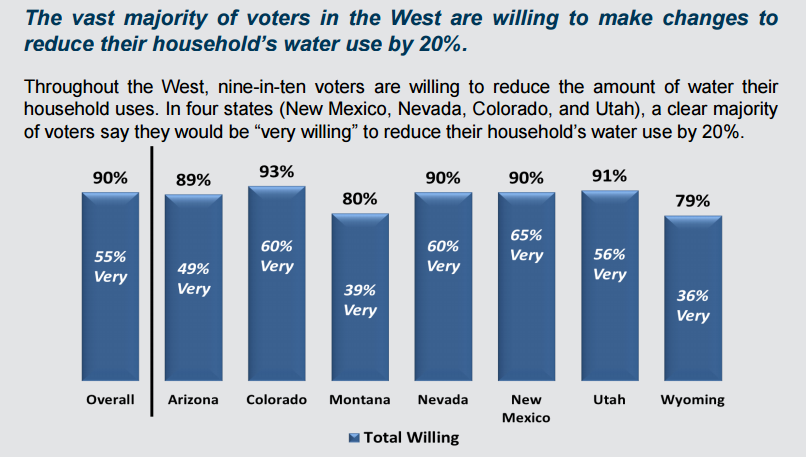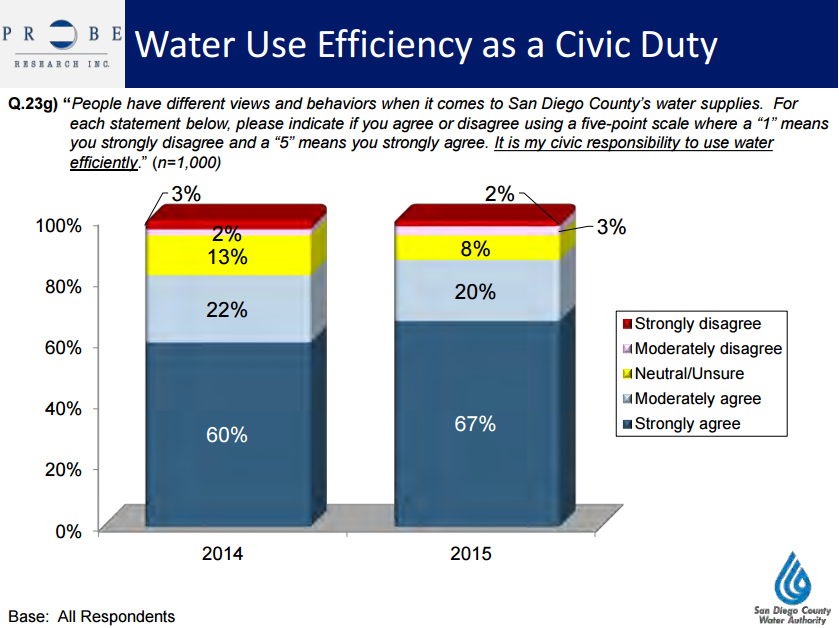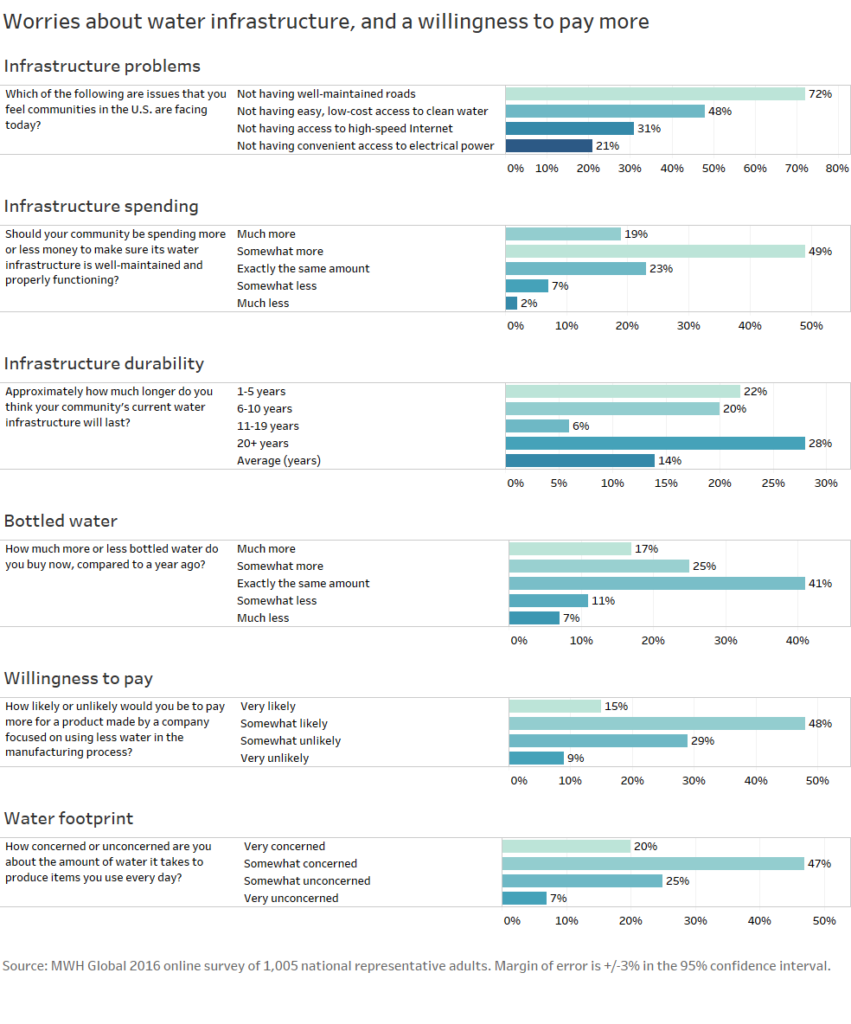6 things I learned by studying public opinion on water
Over the past six months, I’ve been working at the intersection of two professional passions: water and public opinion. With support from the Water Funder Initiative, a collaborate effort by foundations to make our water systems more sustainable, I’ve been analyzing what we know about how the public thinks and feels about water.
One of the strategies in the Water Funder Initiative’s blueprint for philanthropy focuses on strengthening water-related communications and building political will to advance sustainable solutions. Understanding what the public thinks and feels about water is essential for this strategy, so I’ve created WaterPolls.org to aggregate, synthesize, and visualize what we know about water-related public opinion.
Every poll has its own focus and approach, but looking across a variety of water-related surveys, I’ve distilled some key points from the research.
1) Americans are increasingly worried about their drinking water
One of the first things to pop out as you study water-related public opinion is that Americans are deeply concerned about their water. This isn’t a new phenomenon caused by the lead poisoning in Flint and the historic drought in California. For decades, Gallup has asked Americans about a variety of environmental problems and water always winds up as the most troubling issue. “Polluted drinking water and the pollution of rivers, lakes and reservoirs have consistently topped Americans’ concerns throughout Gallup’s 27-year trend measuring these environmental issues,” the organization reported in April 2016.
In its 2016 survey, Gallup found that 61% of Americans worry a “great deal” about pollution of drinking water and another 19% worry a “fair amount.” The results are similar when Gallup asks, somewhat redundantly, about “pollution of rivers, lakes, and reservoirs.” In fact, over more than a quarter-century of polling, Gallup has never found more than 8% of Americans saying they’re “not at all” worried about water pollution.
As shown in the figure below, water has always been more worrisome to Americans than other green issues, such as climate change and the loss of biodiversity. Like air pollution, water quality is far more proximate and real to people than invisible, odorless greenhouse gases or imperiled critters living in some faraway rainforest.
In the American West, where a limited and capricious water supply are perennial challenges, concern about water is probably greater than in wetter parts of the country. In the 2016 Conservation in the West Poll from the State of the Rockies project, about half the people surveyed in seven interior states cited drought and low levels of water in rivers as very or extremely serious problems. By comparison, 43% said unemployment was a very or extremely serious problem.
2) Weather plays major role in shaping public opinion on water
While worries over water are chronic, they certainly ebb and flow with the weather. In 2015, an epic dry spell in California generated an unprecedented finding: for the first time since The Public Policy Institute of California started polling in 1998, water issues were the state’s top issue of concern, eclipsing the economy, jobs, and other matters. As shown in the figure below, 39% of state residents cited water/drought as the most pressing issue in May 2015, ahead of the jobs and the economy at 20%.
After the brutal winter of 2014/2015, one of the driest in centuries, some wetter weather returned to California, and while it wasn’t enough to end the drought, it does appear to have changed how residents think about water. By May 2016, 30% of Californians surveyed cited jobs and the economy as the top issue while only 16% said water and the drought. The graphic below from PPIC shows that as concern fell, so did water conservation.
Weather is something to watch out for when analyzing public opinion on water. During dry spells, pollsters tend to ask more questions about drought and the water supply. Spikes in concern can evaporate once the rain and snow returns. But in California and elsewhere, it appears that many Americans maintain a base level of worry about water regardless of recent precipitation trends.
3) Water-related problems top climate change concerns
Climate change is already manifesting through an amped-up hydrological cycle that is delivering deeper droughts and more extreme floods. Around the world, people are noticing. When the Pew Research Center asked people in 40 countries about their greatest worries related to climate change, drought and water shortages topped the list. The 2015 Pew poll also found high levels of concern over severe weather, such as floods and intense storms. But in all regions there was greater worry about the lack of freshwater, as shown in the figure below.
In the United States, there are some regional differences in concern over climate change causing droughts and water shortages. Nationally, 50% of Americans say drought is their top worry. But that rate ranges from 63% in the drier West to 39% in the wetter East, as one might expect.
Nearly all the surveys I’ve analyzed are based on the public’s opinions, but studies of expert opinion have also revealed fears about the future of our water. In recent surveys conducted by the World Economic Forum, experts have been asked to evaluate dozens of risks confronting the globe and “water crises” have been at or near the top of threats.
4) Water has less of a partisan divide than some other environmental issues
Most political issues have significant partisan gaps in public opinion. Water is no exception, but the gap appears to be smaller than for other environmental issues, such as climate change.
As shown in the figure below, water pollution is the top concern among both Democrats and Republicans. The 25% partisan gap is comparable to the one on air pollution, narrower than the divide on climate change, and wider than the division over loss of tropical rainforests and species (in large part because only around half of Democrats worry a great deal about these issues).
Polling related to two recent state-based efforts show there is broad support for addressing our water woes with sustainable solutions. In July 2014, the Water Foundation asked a bipartisan team of pollsters to analyze Californians’ views on groundwater. Among both Republicans and Democrats, about 80 percent of those surveyed supported “giving local communities increased ability to manage their local groundwater.” Four-fifths of Republican and Democrats also agreed that allowing “anyone to take water from wells without considering impacts on others” was a cause of California’s declining groundwater levels. After decades of political paralysis, California enacted the Sustainable Groundwater Management Act in 2014 and replaced its laissez-faire approach to managing groundwater with a more rational system that keeps local water budgets in balance.
Colorado, my home state, is home to another recent bipartisan success in water. In 2015, the state released a long-awaited plan for meeting the water needs of its booming population in an age of extreme weather. As in other Western states, water has long been a third-rail in Colorado politics. But conservative farmers and trout anglers on Colorado’s Western Slope united with urban progressives and whitewater paddlers in Denver, Boulder, and other Front Range cities to oppose massive new diversions of water across the Continental Divide (most Colorado residents live east of the Divide, but most of the state’s precipitation falls to the west of the continent’s spine.)
Polling connected to the Colorado Water Plan showed strong bipartisan support for sustainable solutions. A 2014 survey supported by environmental NGOs but run by a bipartisan polling team found that large majorities of voters in the swing state supported increasing water conservation in cities and modernizing the state’s water policies. When asked if they supported a statewide goal of reducing water use by 10% by 2020, 99% percent of Democrats, 87% of unaffiliated voters, and 79% of Republicans said yes. Nine in ten Coloradoans think it’s extremely or very important to keep Colorado’s rivers and streams healthy and flowing.
5) Many favor water conservation and see it as a civic duty
Becoming more efficient with our water use is one of the keys to achieving sustainability and greater resilience in the face of climate change. Ask Americans about water conservation, and you’re likely to get a thumbs up. According to the Conservation in the West Poll, which covers Arizona, Colorado, Montana, Nevada, New Mexico, Utah, and Wyoming, the vast majority of Westerners surveyed are willing to take actions in their own lives to reduce their household’s water use by 20%. The poll also found that Westerners overwhelming prefer improving water efficiency over building new dams and diversions in order to meet increasing demands.
When I looked through the results of the San Diego County Water Authority’s polling, one finding that jumped out was how many residents see saving water as a civic duty. The chart below shows that in 2014 and 2015, more than 80 percent of respondents strongly or moderately agreed that “it is my civic responsibility to use water efficiently.” In both years, only 5% percent of people disagreed with the statement.
It’s one thing to say you’ll conserve water, and another thing to actually change your lifestyle or landscaping to achieve the savings. But at least in principle, many Americans think it’s their duty to be water wise, especially during a drought.
6) Americans are willing to spend more to fix their water works
The crumbling of spillways at California’s Oroville Dam was a powerful reminder of the dilapidated state of the nation’s infrastructure. According to the American Water Works Association, the cost of repairing and expanding the nation’s drinking water systems will exceed $1 trillion over the next quarter century. “A new kind of challenge is emerging in the United States, one that for many years was largely buried in our national consciousness,” the group writes. “Now it can be buried no longer. Much of our drinking water infrastructure, the more than one million miles of pipes beneath our streets, is nearing the end of its useful life and approaching the age at which it needs to be replaced.”
A majority of Americans worry about their water infrastructure and say they’re willing to pay more in order to upgrade water works, according to an April 2016 MWH Global survey. Compared to a similar 2015 survey, respondents expressed higher levels of concern and more willingness to pay for upgrades. When asked about the life expectancy of their community’s water infrastructure, people estimated it would last an average of 14 more years. That’s down 2 years from the 2015 results. When asked if their community should be spending more on water infrastructure, 68% of those surveyed in 2016 said yes. That’s up from 61% the year before.
A January 2016 Value of Water Coalition poll found that Americans are willing to pay more on their water bills if they’re informed about infrastructure issues. When asked initially if they were willing to pay more, survey respondents were evenly split: 47% in favor and 47% opposed. But after pollsters provided more information about water issues, support for higher water bills increased to 60%.
Looking ahead to new polling results
Over the next six months, I’ll be continuing to pull together findings from public opinion polls related to water. Several of the polls I’ve mentioned here will be releasing fresh results in the coming months, so it’ll be interesting to see if there are any surprises from surveys released by Gallup, the Public Policy Institute of California, and others.
At least in the American West, the winter thus far has been wet, so as drought conditions improve, we may see a decline in concern over water. Then again, the stormier weather could fizzle and cause drought to return to many areas.
I’ll also be looking to see whether the actions by the new administration prompt new polls on water-related topics.
If you know of other polls I haven’t covered, please drop me a line. And if you have a different take on what existing polls shows, I’d also love to hear from you.
WaterPolls.org aggregates, analyzes, and visualizes public opinion data on water-related issues. Stay informed via Twitter, Facebook, Pinterest, RSS, and email.


